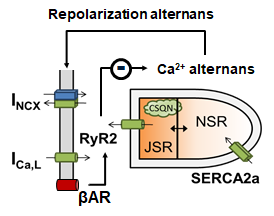R epolarization alternans has been implicated in ventricular arrhythmogenesis and sudden cardiac death, particularly in the infarct border zone (BZ). There exist conflicting data about the effect of sympathetic hyperinnervation on alternans formation and arrhythmogenesis in the BZ. However, detailed experimental characterization of the role of hyperinnervation in BZ arrhythmias is challenging due to the numerous distinct effects of post-infarction remodeling and the diversity of species-specific (sub)cellular mechanisms controlling calcium handling, alternans, and other pro-arrhythmic factors, all of which are modulated by sympathetic stimulation. In this manuscript, we characterized the interplay of BZ electrophysiological remodeling and sympathetic stimulation on alternans formation by fusing an existing state-of-the-art computational model of βAR stimulation in the canine ventricular cardiomyocyte with a model of post-infarction electrophysiological remodeling in the BZ. Our results indicate that βAR stimulation can indeed suppress alternans and we identified a critical role for the regulation of SR calcium release, both through activation of RyR2 channels and indirectly through regulation of SR calcium load, in the suppression of alternans.
epolarization alternans has been implicated in ventricular arrhythmogenesis and sudden cardiac death, particularly in the infarct border zone (BZ). There exist conflicting data about the effect of sympathetic hyperinnervation on alternans formation and arrhythmogenesis in the BZ. However, detailed experimental characterization of the role of hyperinnervation in BZ arrhythmias is challenging due to the numerous distinct effects of post-infarction remodeling and the diversity of species-specific (sub)cellular mechanisms controlling calcium handling, alternans, and other pro-arrhythmic factors, all of which are modulated by sympathetic stimulation. In this manuscript, we characterized the interplay of BZ electrophysiological remodeling and sympathetic stimulation on alternans formation by fusing an existing state-of-the-art computational model of βAR stimulation in the canine ventricular cardiomyocyte with a model of post-infarction electrophysiological remodeling in the BZ. Our results indicate that βAR stimulation can indeed suppress alternans and we identified a critical role for the regulation of SR calcium release, both through activation of RyR2 channels and indirectly through regulation of SR calcium load, in the suppression of alternans.
Reference: Tomek J, Rodriguez B, Bub G, Heijman J (2017) β-adrenergic receptor stimulation inhibits proarrhythmic alternans in post-infarction border zone cardiomyocytes: a computational analysis. Am J Physiol Heart Circ Physiol, Published online on May 26, 2017 – [PubMed]
